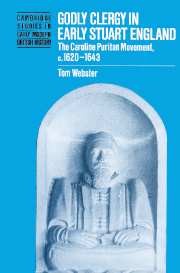Book contents
- Frontmatter
- Contents
- Acknowledgments
- List of abbreviations
- Introduction
- Part I Society, clerical conference and the Church of England
- Part II The godly ministry: piety and practice
- Part III ‘These uncomfortable times’: conformity and the godly ministers 1628–1638
- 7 Thomas Hooker and the conformity debate
- 8 Trajectories of response to Laudianism
- 9 The ecclesiastical courts and the Essex visitation of 1631
- 10 Juxon, Wren and the implementation of Laudianism
- 11 The diocese of Peterborough: a see of conflict
- 12 The metropolitical visitation of Essex and the strategies of evasion
- Part IV ‘These Dangerous Times’: the Puritan Diaspora 1631–1643
- Index
- Cambridge Studies in Early Modern History
11 - The diocese of Peterborough: a see of conflict
Published online by Cambridge University Press: 04 November 2009
- Frontmatter
- Contents
- Acknowledgments
- List of abbreviations
- Introduction
- Part I Society, clerical conference and the Church of England
- Part II The godly ministry: piety and practice
- Part III ‘These uncomfortable times’: conformity and the godly ministers 1628–1638
- 7 Thomas Hooker and the conformity debate
- 8 Trajectories of response to Laudianism
- 9 The ecclesiastical courts and the Essex visitation of 1631
- 10 Juxon, Wren and the implementation of Laudianism
- 11 The diocese of Peterborough: a see of conflict
- 12 The metropolitical visitation of Essex and the strategies of evasion
- Part IV ‘These Dangerous Times’: the Puritan Diaspora 1631–1643
- Index
- Cambridge Studies in Early Modern History
Summary
If we turn to the other county favoured by Emmanuel College, Northamptonshire, we find interesting contrasts and similarities. In some respects the differences can be traced to the different pre-history of the diocese of Peterborough as well as the character of the members of the ecclesiastical hierarchy. Northampton developed a fervent radical Puritanism rather earlier than the eastern counties, especially to be found in the orders of 1571 adopted in Northampton, matching a considerable provision of godly sermons and exercises with a vigorous combination of civic and spiritual government, associated in particular with the evangelism of Percival Wiburn, a former Marian exile. In the 1580s, Northamptonshire developed three well-organised classes with some notes of synodical authority, and Sir Richard Knightley provided a temporary home for the press that produced the virulent Marprelate tracts against episcopacy. Godly ministers in the county and former Northamptonshire incumbents resident in London were crucial in the plans and organisations related to the Hampton Court Conference. In broader terms, the creation of Peterborough as a new diocese at the Reformation, one partitioned off from the vast diocese of Lincoln, created administrative and disciplinary problems, with poverty, uncertainty over the roles of archidiaconal and consistory courts, and the difficulties following from the placing of the cathedral in Peterborough, at some distance from Northampton, the main town in the county. Perhaps as a consequence of the Elizabethan experience of Puritan radicalism, the diocese developed a hierarchy with an early devotion to comparatively ‘high church’ worship, nominally under the rule of Bishop Dove but, given his effective withdrawal into retirement after the 1605 disputes over subscription, under the activism of John Lambe, the chancellor from 1615 to 1629 and…
- Type
- Chapter
- Information
- Godly Clergy in Early Stuart EnglandThe Caroline Puritan Movement, c.1620–1643, pp. 215 - 234Publisher: Cambridge University PressPrint publication year: 1997
- 1
- Cited by



